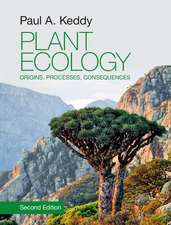A Framework for Community Ecology: Species Pools, Filters and Traits
Autor Paul A. Keddy, Daniel C. Laughlinen Limba Engleză Hardback – 8 dec 2021
| Toate formatele și edițiile | Preț | Express |
|---|---|---|
| Paperback (1) | 289.74 lei 3-5 săpt. | +26.05 lei 4-10 zile |
| Cambridge University Press – 8 dec 2021 | 289.74 lei 3-5 săpt. | +26.05 lei 4-10 zile |
| Hardback (1) | 643.89 lei 6-8 săpt. | |
| Cambridge University Press – 8 dec 2021 | 643.89 lei 6-8 săpt. |
Preț: 643.89 lei
Preț vechi: 723.47 lei
-11% Nou
Puncte Express: 966
Preț estimativ în valută:
123.20€ • 128.65$ • 101.74£
123.20€ • 128.65$ • 101.74£
Carte tipărită la comandă
Livrare economică 15-29 aprilie
Preluare comenzi: 021 569.72.76
Specificații
ISBN-13: 9781316512609
ISBN-10: 1316512606
Pagini: 368
Dimensiuni: 157 x 235 x 22 mm
Greutate: 0.67 kg
Ediția:Nouă
Editura: Cambridge University Press
Colecția Cambridge University Press
Locul publicării:Cambridge, United Kingdom
ISBN-10: 1316512606
Pagini: 368
Dimensiuni: 157 x 235 x 22 mm
Greutate: 0.67 kg
Ediția:Nouă
Editura: Cambridge University Press
Colecția Cambridge University Press
Locul publicării:Cambridge, United Kingdom
Cuprins
Preface; 1. A general framework for community ecology; 2. Filters; 3. Species pools; 4. Traits; 5. Trait-environment interactions; 6. Functional groups; 7. Predictive models of community assembly; 8. Prospects and possibilities; References; Index.
Notă biografică
Descriere
Offers a unifying framework for community ecology by addressing how communities are assembled from species pools.



























